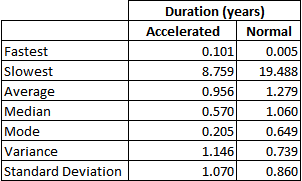In its 14-Dec-2020 “Requests for expedited examination” Practice Notice CIPO explains that it “...does not currently grant requests to examine trademark applications out of order”. The Notice then outlines an exception for “...applications associated with medical goods or services related to COVID-19”. Does the data tell us anything about expedited examination?
CIPO’s trademark .xml files contain 2 potentially relevant elements:
- The <tmk:RequestSearchCategory> element:
- According to CIPO’s Trademarks Data Dictionary this element “indicates when a confusion search has been performed against the trademark” and may encapsulate any one of the text values “No search”, “Normal”, “Accelerated”, “Earlier search” or “Undefined”.
- The <com:RequestExaminationCategory> element:
- According to the Data Dictionary, this element “contains the value indicating if an expedited examination was performed” and may encapsulate any one of the text values “Normal”, “Accelerated” or “Undefined”.
Neither of these elements are exposed by CIPO’s online trademark database—either as searchable fields or otherwise. To investigate these elements one must use CIPO’s .xml data. Also note that CIPO uses the terms “accelerated” and “expedited” interchangeably.
Looking first at the <tmk:RequestSearchCategory> element, as of 15 March 2021:
- none of CIPO’s 1,771,559 .xml files contain an “Accelerated” <tmk:RequestSearchCategory> element.
- 1,730,709 of those files contain a “Normal” <tmk:RequestSearchCategory> element.
- The remaining 40,850 files contain a “No search” <tmk:RequestSearchCategory> element. As might be expected, these correspond to special mark classes, namely Prohibited/Official (i.e. TMA Section 9) marks; Denominations recorded pursuant to the Plant Breeder’s Rights Act, SC 1990 c. 20; Geographical Indications and Newfoundland trademarks.
Turning to the <com:RequestExaminationCategory> element, as of 15 March 2021:
- 1,770,267 of CIPO’s 1,771,559 .xml files contain a “Normal” <com:RequestExaminationCategory> element.
- The remaining 1,292 files contain an “Accelerated” <com:RequestExaminationCategory> element.
- Of those 1,292 files:
- 1,256 pertain to trademarks,
- 19 to certification marks,
- 10 to Prohibited (i.e. Official) marks, and
- 7 to distinguishing guises.
- The most recent “Accelerated” examination application was filed on 16-Jul-2019 (see application no. 1975779)
- 124 “Accelerated” examination requests have been granted since 2010:
So, how fast is “Accelerated” relative to “Normal” examination? There are no prosecution event elements in CIPO’s trademark .xml data to indicate when a request for accelerated examination may have been filed—or granted. Such requests might be filed concurrently with the application or at any time before approval of the application for advertisement in the Trademarks Journal. I will use the filing-to-advertisement time duration to compare the prosecution times of applications which have undergone “Normal” vs. “Accelerated” examination.
Of the aforementioned 1,292 “Accelerated” examination cases I will ignore the 36 Prohibited (Official) marks / certification marks and distinguishing guises, since their examination procedure differs somewhat from the examination of trademark applications. That leaves 1,256 trademark applications, of which 1,076 had reached the advertisement stage as of 15-Mar-2021 (some cases were abandoned prior to advertisement and at least one had not progressed as far as advertisement as of 15-Mar-2021). Those 1,076 cases were filed between 30-Sep-1985 and 03-Apr-2018 inclusive. During the same filing date interval 1,014,587 trademark applications reached the advertisement stage via “Normal” examination. The table below provides statistical measures1 comparing filing-to-advertisement elapsed times for these “Accelerated” vs. “Normal” examination trademark applications.
The foregoing serves to confirm the reality with which experienced practitioners will be familiar:
- expedited examination of a Canadian trademark application is rare: only 0.11% of the trademark applications filed between 30-Sep-1985 and 03-Apr-2018 underwent accelerated examination;
- no requests for expedited examination have been granted since 16-Jul-2019 (according to CIPO’s .xml data); and
- although expedited examination is generally faster than normal examination, it is not dramatically faster (since all applications must pass through the same procedural steps and thus inevitably encounter various bottlenecks inherent in those steps).
Lastly, CIPO’s grant of a request for expedited search and examination should not be confused with situations in which CIPO may—on its own initiative—commence prosecution of an application out of the application’s filing order sequence relative to other applications. That indeed happens in certain situations, as I will explain in a future post.
1 The median is the middle value in a set of values. The mode is the value that occurs most often in a set of values. Variance indicates how far a set of values are spread out from their average value. Standard deviation indicates the amount of variation or dispersion in a set of values (low standard deviation indicates that the values tend to be closer to the set’s average value; high standard deviation indicates that the values are spread out over a wider range).
↩
2 See Metro-Goldwyn-Mayer Lion Corp. v Attorney General of Canada et al., FCTD file no. T-1650-10 directing the Registrar to approve the application for advertisement.↩



